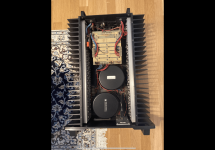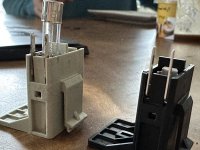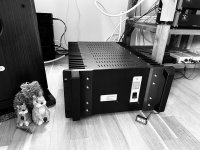If they barely get warm and your house is in the 70's as far as temperature, then the bias is far too low. It isn't super hard to adjust the bias on these. If you don't feel confident, a skilled tech would be a good idea. I would adjust the bias so that the heatsinks are around 42-46 degrees celcius. That should be a good safety margin.
I've had the S/1000 Series II, the SA/1 and SA/1 optical bias. The SA12e is the latest Class A amp from threshold and the most powerful. The SA/1 is stable up to 2 Ohms. I powered Acoustat 2 + 2 fullrange electrostatics with it like J Gordon Holt (First his Martin Logan Monoliths II I believe and SoundLab fullrange electrostatics) so you probably won't need the extra power of the SA/12 besides the SA/1 has beautiful meters!Hello everyone, I'm new to this forum, but have been following some of your threads. This question should be direceted to Mr Pass himself, but if anyone has any experience with an sa/1 comparison to the sa/12e, could you please share. I am considering one of these amps, but not sure what the differences in character are. I have heard the sa/1's and absolutely loved them. Just wondering if the sa/12e are an extension of the sa/1's or do they give anything up for the extra power? the sa/12e amps seem to be extremely hard to come by, even compared to the sa/1's. To Mr. Pass, I really wished you had put the meters on the sa/12e also, they looked gorgeous, besides gives you a sense on where the amplifier is in output, just my opinion. Thank you to you all and hope to get some feed back.
Is there somewhere a document explaining how to adjust the bias of SA12s?If they barely get warm and your house is in the 70's as far as temperature, then the bias is far too low. It isn't super hard to adjust the bias on these. If you don't feel confident, a skilled tech would be a good idea. I would adjust the bias so that the heatsinks are around 42-46 degrees celcius. That should be a good safety margin.
correct, that’s should be the one, I just opened the top cover, do you know where P1 could be hidden? Is the adjustment possible without opening the amp?No but I do have the schematic. I see one pot in the schematic. P1. I attached the PDF file. Let me know if it pulls up alright.
Attachments
On the S500, you have to remove the back panel to gain access to it. Fairly easy. Should only be 8 Phillips head boltscorrect, that’s should be the one, I just opened the top cover, do you know where P1 could be hidden? Is the adjustment possible without opening the amp?
Be cautious when turning the pot. I believe it is only a single turn.
Typically on these old threshold amps you just put the multimeter across a sorce resistor measuring DC.
You only want to do a little bit at a time. Place the temperature could settle. Put the top back on.
Typically on these old threshold amps you just put the multimeter across a sorce resistor measuring DC.
You only want to do a little bit at a time. Place the temperature could settle. Put the top back on.
Last edited:
I still have to figure out where the pot is, so by back panel you mean the panel where the amp inputs And outputs are connected to?On the S500, you have to remove the back panel to gain access to it. Fairly easy. Should only be 8 Phillips head bolts
Yes. You will see that the RCA XLR power ETC although accessible from the back is actually attached to the heatsinks. It is a really smart design. When you take the cover off, they stay put, yet all the guts are exposed. Take the 8 screws off of the back panel and you will see on the little board (the small one attached to the amplifier section on the left in your pic) there may be a trimmer pot facing towards the back. You will want a pretty small flathead screwdriver. I also put heat-shrink, electrical tape etc. on my screw driver shafts to minimize the conductive surface in case I bump into something.
You will want to put the multimeter across one of the source resistors. Take note of the reading. I suspect with that many outputs, it may be something around 40mv-80mv but that is an uneducated guess. I don't know the math required to figure it out and don't have the specs.
I use something like this to hook onto the source resistor:
clip leads
I also try to use the same source resistor each time. Maybe put a black dot next to it with a permanent marker or something.
You will also want to check your DC offset. I like to use two meters, one to keep an eye on the offset as well while I adjust the bias with the other. If the offset changes, then you know you have an offset pot as well or something isn't liking the bias adjustment... For the offset, one lead on the + & - binding posts (You ill want below 50mv).
Only do like say a 5mv increase in bias at a time since you are just starting out. You will want to put the cover on (if you have the clip leads, you can do so with them attached, just don't screw the cover on. Keep an eye on temp. When you are getting close, you can take the leads off and let things settle with the top screwed in to see where things are at.
You will want to put the multimeter across one of the source resistors. Take note of the reading. I suspect with that many outputs, it may be something around 40mv-80mv but that is an uneducated guess. I don't know the math required to figure it out and don't have the specs.
I use something like this to hook onto the source resistor:
clip leads
I also try to use the same source resistor each time. Maybe put a black dot next to it with a permanent marker or something.
You will also want to check your DC offset. I like to use two meters, one to keep an eye on the offset as well while I adjust the bias with the other. If the offset changes, then you know you have an offset pot as well or something isn't liking the bias adjustment... For the offset, one lead on the + & - binding posts (You ill want below 50mv).
Only do like say a 5mv increase in bias at a time since you are just starting out. You will want to put the cover on (if you have the clip leads, you can do so with them attached, just don't screw the cover on. Keep an eye on temp. When you are getting close, you can take the leads off and let things settle with the top screwed in to see where things are at.
I still haven’t adjusted the SA12 bias, I kinda like their sound, at room temperature of about 16-17 C and about 2 hrs of playing, the temperature of the radiator blades reaches about 36-39 C. But I did chang the AC mains fuse drawer, I found the part in Digikey (Schurter). The old fuse drawer (the white one in the photo) had a lot of oxidation and some melted metal parts. After changing to a new part my first impression was some improvement in bass and lower frequencies. Might need some more burn in time but let’s see. Maybe the explanation for more bass, was more current (less resistance) in the path.
Attachments
I would say the whole amp is a piece of art, couldn’t be happier with that. Thanks Nelson for your creation. I was born in 1985 so perhaps you already came up with the design around those years.Chassis/faceplate design was done by business partner Rene Besne.
😎
That’s the preamp which made me fall in love with the music, your Threshold PCR1 (Parallel Coherence Reference). As far as I know the only one in Germany.And what handsome preamp is that?
Do you have the schematic of this amp? there exists basically no information about it..
regards,
Karl
Last edited:
That's the prototype PCR-1 from the late Wernher Baden the German Threshold/Pass Labs importer WBS. It has a serial ending beginning with 79 and ending with 002 designating: made in 1979 the second one. You probably bought it from CJM Audio.That’s the preamp which made me fall in love with the music, your Threshold PCR1 (Parallel Coherence Reference). As far as I know the only one in Germany.
Do you have the schematic of this amp? there exists basically no information about it..
regards,
KarlView attachment 1130094
It's a treasure now of course but the right thing todo is the give it back to NP...;-)
Hi Robert!
I didn’t know there is also another one, how cool is it. Do you have track of that second unit? Surly it’s a collectible.
I didn’t know there is also another one, how cool is it. Do you have track of that second unit? Surly it’s a collectible.
There were only two. The other went to Electori in Japan.
As far as I know the one that you have (probably serial 7910001, meaning manufactured in week 10, 1979 the first one).Hi Robert!
I didn’t know there is also another one, how cool is it. Do you have track of that second unit? Surly it’s a collectible.
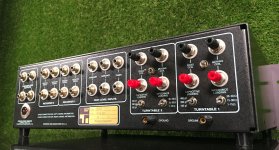
It came up for sale in Germany @ Ebay.de something like 15 years ago for 1.700 EUR as I remember. I asked the seller what it was and he said correctly that it was a Threshold prototype. I did not know it at all and I did not inquire any further...😴
As I said, the German one belonged as far as I know to the late Werner Baden:
I met with one of his former technicians Roland Fischer this weekend, who worked decades for WBS, and bought a couple of SA/1's.
Would be great if you could get the Stasis 1 mono's also:
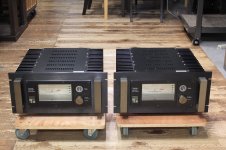
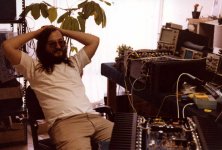
But you have a real collectible an a beautiful looking and probably sounding pre-amp and I congratulate you with that!
- Home
- Amplifiers
- Pass Labs
- Threshold SA/1 vs SA/12E
